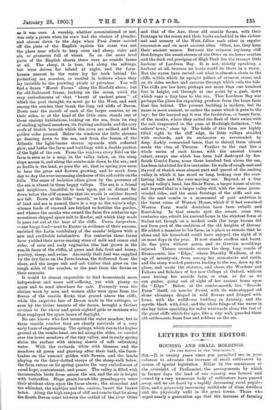SEASIDE FARMS. A S a rule, in old England there
were few farmhouses near IDL. to the sea. In those days when Britain only ruled the waves intermittently the sea was as much the enemy's as it was ours. A warship, whether commissioned or not, was only a pirate when its crew had the chance of plunder, and almost down to the days when Paul Jones carried off the plate of the English squires the coast was not the place near which to keep oxen and sheep, cider and ale, or granaries full of wheat. So on the more level parts of the English shores there were no seaside farms at all. The sheep, it is true, fed along the saltings, but were driven far inland at night, and the farm- houses nearest to the water lay far back behind the protecting sea marshes, or nestled in hollows where they lay invisible to the prowling pirate or privateer. You will find a dozen " Marsh Farms " along the Norfolk shore ; but for old-fashioned farms, looking on the ocean, amid the very embodiments of that " haunt of ancient peace " of which the poet thought, we must go to the West, and seek among the combos that break the long red cliffs of Devon. Down near the mouth of each of the larger combos, or on their sides, or at the head of the little ones, stands one of these ancient habitations, looking on the sea, from its ring of smiling upland meadows, its fruiting orchards, and the cosy roofs of thatch beneath which the cows are milked and the golden cider pressed. Below its windows the little streams go dancing down to the sea, and from the bosom of the Atlantic the light-beams stream upwards with reflected glow, and bathe the farm and buildings with a double portion of the light of the sun. From the windows every field on the farm is seen as in a map, in the valley below, on the steep slope across it, and along the combe-side down to the sea; and ao fertile is the land, so pure the air, that in spring you seem to hear the grass and flowers growing, and to mark from day to day the ever-increasing sleekness of the red cattle on the hills. The sense of isolation often given by the presence of the sea is absent in these happy valleys. The sea is a friend and neighbour, beautiful to look upon, yet so distant far down below the cliff summits that its wrath is neither feared nor felt. Down at the little "mouth," as the lowest meeting of land and sea is named, there is a way to the water's edge, whence loads of seaweed are fetched to fertilise the garden, and whence the monks who owned the farm five centuries ago sometimes shipped spare salt to Exeter, salt which they made in pans cut out at the base of the cliffs. Unum bargeafum, —one barge-load—sent to Exeter in evidence of their success, enriched the Latin vocabulary of the monks' ledgers with a new and creditable substantive. For centuries these farms have yielded their never-ceasing store of milk and cream and cider, of corn and, early vegetables (the last grown in the Bun-lit faces of the cliffs), of game and fish, fruit and honey, poultry, sheep, and swine. Anciently their fuel was supplied by the dry furze on the furze-brakes, the driftwood from the shore, and the larger oak and ash timber that grew on the rough sides of the combos, or the peat from the downs on their summits.
It would be almost impossible to find homesteads more independent and more self-sufficing, yet with plenty to spare and to send elsewhere for sale. Formerly even the clothes worn by men and women alike were spun from the fleeces of the seaside flocks that grazed above the cliffs, while the exquisite lace of Devon made in the cottages, or even by the richer tenants of the farms, brought a further revenue to the clever and quick-sighted girls or mothers who thus employed the spare hours of daylight.
No one knows who first invented the water meadow, but in these seaside combes they are clearly survivals of a very early form of engineering. The springs, which rise in the higher ground at the combe-head, are led along the sides, or carried over the lower meadows of the tiny valley, and in early spring sluice the surface with shining sheets of soft refreshing water. With the orchards white with blossom and the meadows all green and growing after their bath, the furze- brakes on the summit golden with flowers, and the lambs playing on the daisy-dotted steeps of the sheep-walk below, the farm enters on its spring quarter the very embodiment of rural hope, contentment, and peace. The valley is filled with innumerable birds from across the sea, and the air is bright with butterflies. Huge green locust-like grasshoppers utter their strident chirp upon the furze above ; the stonechat and the whinehat, the nightjar and the cuckoo, haunt the brakes beloiv. Alimg the high ranges of cliff and combs that lie along the South Devon coast between the outfall of the river Otter
and that of the Axe, these old seaside farms, with their frontage to the ocean and their backs embedded in the richest soil and scenery of the West, follow each other in regular succession and on most ancient sites. Often, too, they keep their ancient names. Between the crimson ivy-hung cliff that fringes the sweet stream of the Otter on its lower reaches and the dark-red precipice of High Peak lies the strange little harbour of Lardram Bay. It is not, strictly speaking, a harbour at all, because no boats could lie there in a storm. But the waves have carved out what is almost a circle in the cliffs, within which lie upright pillars of crimson stone, and on its sides arches and caverns through which rolls the tide. The cliffs are low here, perhaps not more than one hundred feet in height, cut through at one point by a gash, down which runs a tiny lane to the sea. This Lardram Bay was perhaps the place for exporting produce from the large farm that lies behind. The present building is modern, but its name is most ancient, or rather the name which it gave to the bay; for the learned say it was the /ardarium, or bacon farm, of the monks, where they salted the flesh of their swine with the salt evaporated in the pans at Budleigh-Salterton, " the salters' town," close by. The fields of this farm are highly tilled right to the cliff edge, its little valleys studded with orchards, and its enclosures so surrounded by deep, darkly overarched lanes, that to thread them almost needs the clue of Theseus. Further to the east lies a whole series of such farms, with the ancient houses intact, except one which has been half destroyed by fire. South Combo Farm, some three hundred feet above the sea, has been inhabited for five centuries. Its walls of rough-cast and its roof of thatch seem almost part and parcel of the smiling valley in which it has stood so long, looking over the ever- lasting hills and the ever-moving sea. Beyond, at a tiny upland valley's head, lies Slade Farm, a larger house of stone, and beyond that is a larger valley still, with the same green- wooded sides, and the same frontage of the cliffs and sea. In the next combo is a monument of past ambition in the burnt ruins of Weston House, which if it had remained Weston Farm would doubtless have been rebuilt and flourishing. In that remote spot the owner, some two centuries ago, rebuilt his ancient home in the strictest form of Italian art, though on a modest scale (for large houses did not form part of the ambition of the old knights of Devon). He added a mansion to his farm, in a place so remote that he alone and his household could have enjoyed the sight of it on most days in the year. It now stands roofless and burnt, its fine piers without gates, and its Grecian mouldings injured. Thence onwards, across the deep, long combo of Branscombe, lies "Edge," where Dorothy Wadham, at the age of seventy-six, from among her corn-stacks and cattle, and the steep wooded pastures leading to the sea, drew up the plans, and wrote the statutes, and chose the Wardens and Fellows and Scholars of her new College at Oxford, without once leaving her seaside farm, or even, so far as we can gather, going out of sight of her ancient home upon the " Edge." Below, at the combo-mouth, lies " Seaside Farm" itself, sic nomine dicunt, with its wide-stepped old stone chimneys draped in wild flowers and fringed with ferns, with the wallflower budding in January, and the myrtle black with fruit, and the white fringe of the waves in the bay below sparkling for miles westwards along the feet of the giant cliffs which for ages, like a city wall, guarded these old settlements from foes and robbers on the sea.























































 Previous page
Previous page